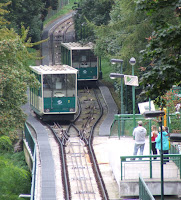 Over the last two decades, the city of Prague has become well-established as a major European tourist destination.
Over the last two decades, the city of Prague has become well-established as a major European tourist destination.During the Cold War decades which followed the Second World War, as the capital city of Czechoslovakia, this historic gem was hidden behind the Iron Curtain. The end of the communist era brought the opening of borders between Eastern Europe and the West, making it far easier for people from outside Eastern Europe to visit. In 1992 Prague gained UNESCO World Heritage Site status for much of the historic city centre.
The rapid political changes of the early 1990s spelled the end for Czechoslovakia as it split into two independent nations, Slovakia and the Czech Republic, at the start of 1993.

Prague has trams aplenty. The tram network is one of the busiest and most intensive in the world. Trams, combined with an expanding Metro system, form the backbone of Prague's public transport system.
 The oldest trams date from the communist era, when Prague was home to a large tram-building plant. Produced in their thousands, trams of this design were supplied to cities across the Soviet bloc.
The oldest trams date from the communist era, when Prague was home to a large tram-building plant. Produced in their thousands, trams of this design were supplied to cities across the Soviet bloc.When I visited Prague in Autumn 2011, hundreds of them were still operating, generally in pairs.




One practice I have observed in some cities in Central and Eastern Europe is trams stopping in the middle of the street to allow passengers on and off. Other traffic is required to stop while trams are loading and unloading.
 Towards the end of the communist era, articulated trams to a newer design were introduced.
Towards the end of the communist era, articulated trams to a newer design were introduced.These are Prague's only trams which are bi-directional, having doors on both sides and driving cabs at both ends.
 Some of the articulated units have been altered with a low-floor centre section providing easier access to disabled passengers.
Some of the articulated units have been altered with a low-floor centre section providing easier access to disabled passengers. Further single tramcars entered service in the 1990s. Most operate in pairs.
Further single tramcars entered service in the 1990s. Most operate in pairs.

 A small number of single cars operate on certain routes at certain times.
A small number of single cars operate on certain routes at certain times.

In recent years, purpose-built articulated low floor trams have entered service in Prague.



These older-looking trams had me fooled. I had thought they were from the communist era, converted to provide a low floor section.
In fact, as I discovered from discussion on the Eurotrams Yahoo group, the bodies were purpose-built in the 21st Century, although some of the mechanical parts and underframes may be older.

 A pair of vintage tramcars are a static feature in Wenceslas Square, in use as a café.
A pair of vintage tramcars are a static feature in Wenceslas Square, in use as a café.At weekends from the end of March until mid-November, vintage trams operate a heritage service through the city centre. Special fares apply.
 On the west bank of the River Vltava, Petřín Hill offers good views across the city from an observation tower. It was an exhibition site in the late 19th Century. A legacy from the exhibition is a funicular railway which climbs the hill.
On the west bank of the River Vltava, Petřín Hill offers good views across the city from an observation tower. It was an exhibition site in the late 19th Century. A legacy from the exhibition is a funicular railway which climbs the hill. 
 So, that's the trams and the funicular, but what about the buses?
So, that's the trams and the funicular, but what about the buses?Prague has plenty of bus services - but visitors to the city are unlikely to see many of them. Buses generally operate in the suburbs, feeding passengers to the tram and metro systems. Very few buses enter the heart of the city. The only bus I did notice in the city centre was an articulated vehicle.
As in most of the cities I have visited outside the UK, an integrated fare system applies. Single-fare tickets allow the passenger to transfer between different routes, and between bus, metro, tram and funicular for up to 30 or 90 minutes, depending on the fare paid. Tickets are bought at metro stations, retail outlets and from machines at some tram stops, then validated on entering the system (or on boarding).
The public transport network is provided by Dopravní podnik hlavního města Prahy (DPP), and overseen by Regionální organizátor Pražské integrované dopravy (PID). More detailed information about Prague's public transport system, from both a user and enthusiast perspective, can be found here.




No comments:
Post a Comment